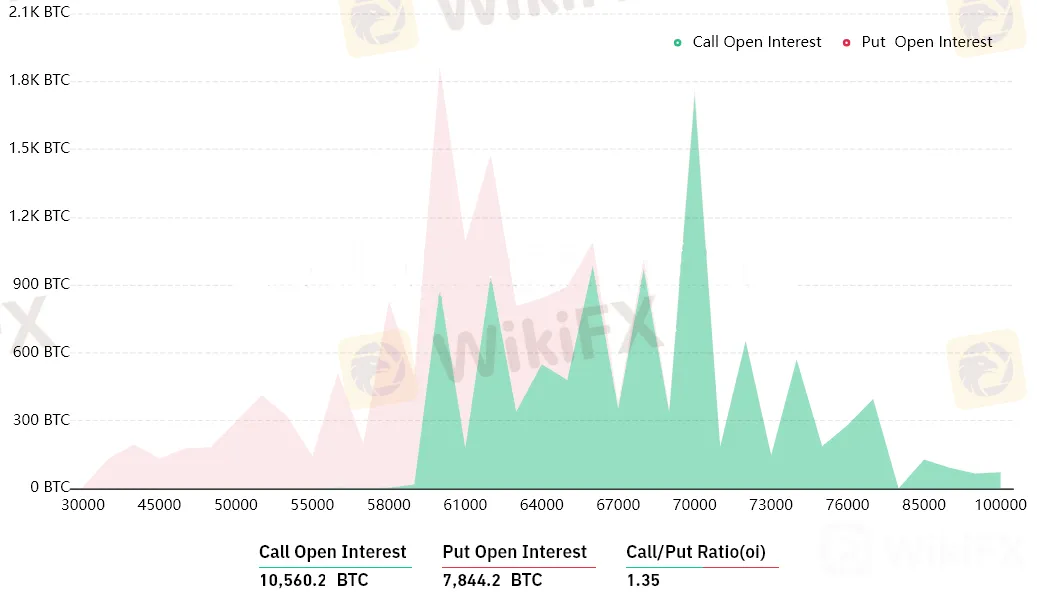简体中文
繁體中文
English
Pусский
日本語
ภาษาไทย
Tiếng Việt
Bahasa Indonesia
Español
हिन्दी
Filippiiniläinen
Français
Deutsch
Português
Türkçe
한국어
العربية
Here’s why bears hope to pin Bitcoin under $60K ahead of Friday’s $1.1B options expiry
Abstract:Last week, bulls had a $715 million advantage when Bitcoin price was above $68,000, but the current downturn gives bears a chance to turn the tables.

Bitcoin (BTC) bulls were euphoric when the price soared to $69,000 on Nov. 10 because the 14.5% gain accumulated over five days meant they were in for a $715 million profit on Nov. 12's options expiry.
However, the 9% negative price move on Nov. 16 caught bulls by surprise, especially since most of the call (buy) options for Nov. 19 have been placed at $66,000 or higher. Curiously, that price level has been the exception rather than the norm.
Bears might have been lucky because the two negative events happened in the past few days. On Nov. 12, the United States Securities and Exchange Commission denied VanEcks spot Bitcoin ETF request. But more important than the rejection, itself, which was largely expected, was the rationale behind the decision.
The SEC explicitly mentioned their uncertainties about Tether‘s (USDT) stablecoin and the lack of ability to deter fraud and market manipulation in Bitcoin trading. Bloomberg senior ETF analyst and cryptocurrency expert Eric Balchunas had already given a 1% chance for approval so the denial wasn’t really a surprise.
Moreover, on Nov. 15, U.S. President Joe Biden sanctioned the infrastructure bill, which mandates that starting in 2024, digital asset transactions worth more than $10,000 be reported to the Internal Revenue Service.
Considering the above scenario, bulls are likely to regret their lack of more conservative bets on Nov. 19s $1.1-billion weekly options expiry.
At first sight, the $630 million call (buy) options dominate the weekly expiry by 35% compared to the $470 million put (sell) instruments. Still, the 1.35 call-to-put ratio is deceptive because the recent price crash will probably wipe out most bullish bets.
For example, if Bitcoin‘s price remains below $62,000 at 8:00 am UTC on Nov. 19, only $68 million worth of those call (buy) options will be available at the expiry. For example, there is no value in the right to buy Bitcoin at $64,000 if it’s trading below that price.

Bears have their eyes set on prices below $60,000
Listed below are the four most likely scenarios for the $1.1-billion Nov. 19 expiry. The imbalance favoring each side represents the theoretical profit. In other words, depending on the expiry price, the quantity of call (buy) and put (sell) contracts becoming active varies:
Between $58,000 and $60,000: 10 calls vs. 3,840 puts. The net result is $220 million favoring the put (bear) options.
Between $60,000 and $62,000: 910 calls vs. 1,950 puts. The net result is $60 million favoring the put (bear) instruments.
Between $62,000 and $64,000: 2,030 calls vs. 940 puts. The net result is $70 million favoring the call (bull) options.
Above $64,000: 2,920 calls vs. 240 puts. The net result is $175 million favoring the call (bull) instruments.

This crude estimate considers call options being used in bullish bets and put options exclusively in neutral-to-bearish trades. However, this oversimplification disregards more complex investment strategies.
For instance, a trader could have sold a put option, effectively gaining a positive exposure to Bitcoin (BTC) above a specific price. But, unfortunately, theres no easy way to estimate this effect.
Bulls need a 6% price hike to turn the tables
The only way for bulls to profit a significant amount on Nov. 19‘s expiry is by pushing Bitcoin’s price above $64,000, which is 6% away from the current $60,400. If the current short-term negative sentiment prevails, bears could exert some pressure and try to score up to $220 million in profit if Bitcoin price stays closer to $58,000.
Currently, options markets data slightly favor the put (sell) options, slightly reducing the odds of a rally ahead of Nov. 19.
Disclaimer:
The views in this article only represent the author's personal views, and do not constitute investment advice on this platform. This platform does not guarantee the accuracy, completeness and timeliness of the information in the article, and will not be liable for any loss caused by the use of or reliance on the information in the article.
Read more

INZO Broker MT5 Review 2025: A Trader's Guide to Features, Fees and Risks
INZO is a foreign exchange (Forex) and Contracts for Difference (CFD) brokerage company that started working in 2021. The company is registered in Saint Vincent and the Grenadines and regulated offshore. It focuses on serving clients around the world by giving them access to popular trading platforms, especially MetaTrader 5 (MT5) and cTrader. The company offers different types of trading instruments, from currency pairs to cryptocurrencies. It aims to help both new and experienced traders. Read on to know more about it.

INZO Broker No Deposit Bonus: A 2025 Deep Dive into Its Offers and Risks
Traders looking for an "inzo broker no deposit bonus" should understand an important difference. While this term is popular, our research shows that the broker's current promotions focus on a $30 welcome bonus and a 30% deposit bonus, rather than a true no-deposit offer. A no-deposit bonus usually gives trading funds without requiring any capital from the client first. In contrast, welcome and deposit bonuses often have rules tied to funding an account or meeting specific trading amounts before profits can be taken out. This article gives a complete, balanced look at INZO's bonus structure, how it operates, and the major risks shown by real trader experiences. Read on!

Why Bitcoin Is Falling?
Bitcoin (BTC) plunged to $104,288 on Tuesday, extending its decline for a second consecutive session and breaking below the critical 200-day moving average. The selloff follows the worst October in a decade.

Webull Resumes Crypto Trading, Eyes Global Expansion Starting with Brazil
Webull re-enters the crypto market, launching services in Brazil with a Coinbase partnership. Plans for US rollout signal broader industry trends and renewed digital asset access for users.
WikiFX Broker
Latest News
Consob Targets Political Deepfake “Clone Sites” and Unlicensed Platforms in Latest Enforcement Round
WikiEXPO Global Expert Interviews: Gustavo Antonio Montero: ESG in Finance
Global Guide to Finding Forex IBs/Brokers — Share Your Pick and Win Big!
Trump tariffs are helping drive U.S. beef prices to new highs
Mitrade Arabic Platform Targets MENA Gold Trading Boom
Israeli Arrested in Rome Over €50M Forex Scam
Scam Alert: GINKGO-my.com is Draining Millions from Malaysians!
New FCA Consumer Alert 2025: Important Warning for All Consumers
EmiraX Markets Withdrawal Issues Exposed
Trading Pro Review: Scam Broker Exposed
Currency Calculator



